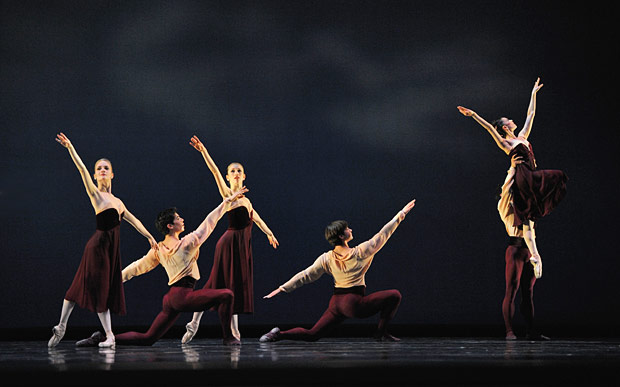
© Erik Tomasson. (Click image for larger version)
San Francisco Ballet
Maelstrom, Within the Golden Hour, Glass Pieces
Paris, Théâtre du Châtelet
17 July 2014
www.sfballet.org
chatelet-theatre.com
If you’ve got a big company of dancers, show them off in programmes that don’t simply use small casts. Helgi Tomasson must have borne that mantra in mind when he selected San Francisco Ballet’s triple bill with Jerome Robbins’s mass-effect Glass Pieces and Mark Morris’s Maelstrom on either side of Christopher Wheeldon’s compact Within the Golden Hour.
Maelstrom (1994), the first of eight Morris creations for SFB, subverts the conventions of classical ballet while making use of its forms. His enchaînements – step combinations – at first disconcerting, become familiar as they are repeated on recurring phrases of the music, Beethoven’s Trio for Piano, Violin and Cello no 5. Dancers go in and out of synch, punctuating the end of a phrase by lifting a hand or flexing a foot. Even when they’re in unison, they all look like individuals, interpeting the music their own way; someone will pop out of the wings and retreat, as if they’ve remembered somewhere else to go.
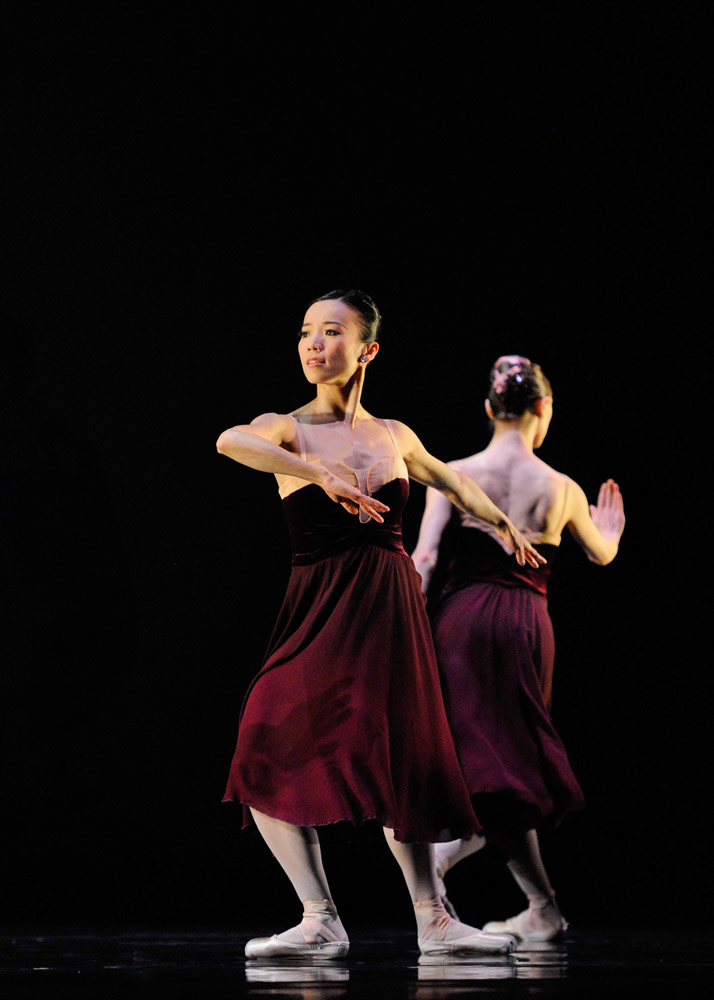
© Erik Tomasson. (Click image for larger version)
In the haunting slow movement from which Beethoven’s trio takes its nickname of ‘The Ghost’, 14 dancers walk relentlessly, progressing across the stage in the same steps, like wilis or bayadères. Men do as women do, including posing in 90 degree arabesques. Yet the male/female partnering is invariably courteous, respectful, as couples ebb and flow across the stage.
Though the title refers to a trubulent whirlpool, these ripples of movement are highly organised. By the cheerful last movement, the dancers’ reprises are so exactly on the music that they’re comical. All 14 are caught up in an irresistible process, working out Beethoven’s finale as a communal endeavour with the trio of musicians. Twenty years after Maelstrom’s creation for SFB, new generations of dancers are finding what fun Morris can be.

© Erik Tomasson. (Click image for larger version)
When Robbins choreographed Glass Pieces in 1983, Philip Glass’s mesmeric music was new to ballet, though not to contemporary dance. Robbins presented New York City Ballet’s dancers as busy pedestrians striding along the city’s crowded sidewalks, narrrowly avoiding collisions and dog poo. They weren’t ordinary commuters, though, because they wore trendy dance clothes. (I think I remember headbands and ankle-warmers, now discarded.) Emerging from the anonymous crowd, couples were isolated in private pas de deux. Glass Pieces was a forerunner of Wayne McGregor’s Infra, with its electronic parade of marching figures, spotlit duets and stream of street people at the end.
In ‘Façades’, the second section of Glass Pieces, the central pas de deux takes place in front of a silhouetted frieze of corps de ballet girls, swaying and shuffling in tiny steps. Sofiane Sylve and Luke Ingham are glorious in the slow-motion soaring duet with its poses in parallel, recalling Ancient Egyptian tomb paintings.

© Erik Tomasson. (Click image for larger version)
Glass’s music for his opera Akhnaten (a decadent Egyptian pharaoh) is used for the final section, when the corps of 38 let rip in jazz and modern ballet routines. No longer pedestrians, they obey the regimented demands of a Broadway show, keeping in time and in unison: this is a Robbins ritual, skilfully designed to arouse applause. It’s a winner.
Wheeldon’s Within the Golden Hour (2008) was performed at Sadler’s Wells during SFB’s last London season two years ago. It uses 14 dancers in a series of episodes to light, repetitive music for strings by contemporary composer Ezio Bosso, with an additional andante by Vivaldi. Wheeldon’s balletic vocabulary becomes even more quixotic than Morris’s in Maelstrom. Men embrace the floor in V-shapes, women pulse their legs like jellyfish in upside-down lifts, undulate their shoulders in exotic ports de bras. They are costumed by Martin Pakledinaz as temple dancers in subtle shades of gold, blue and green.
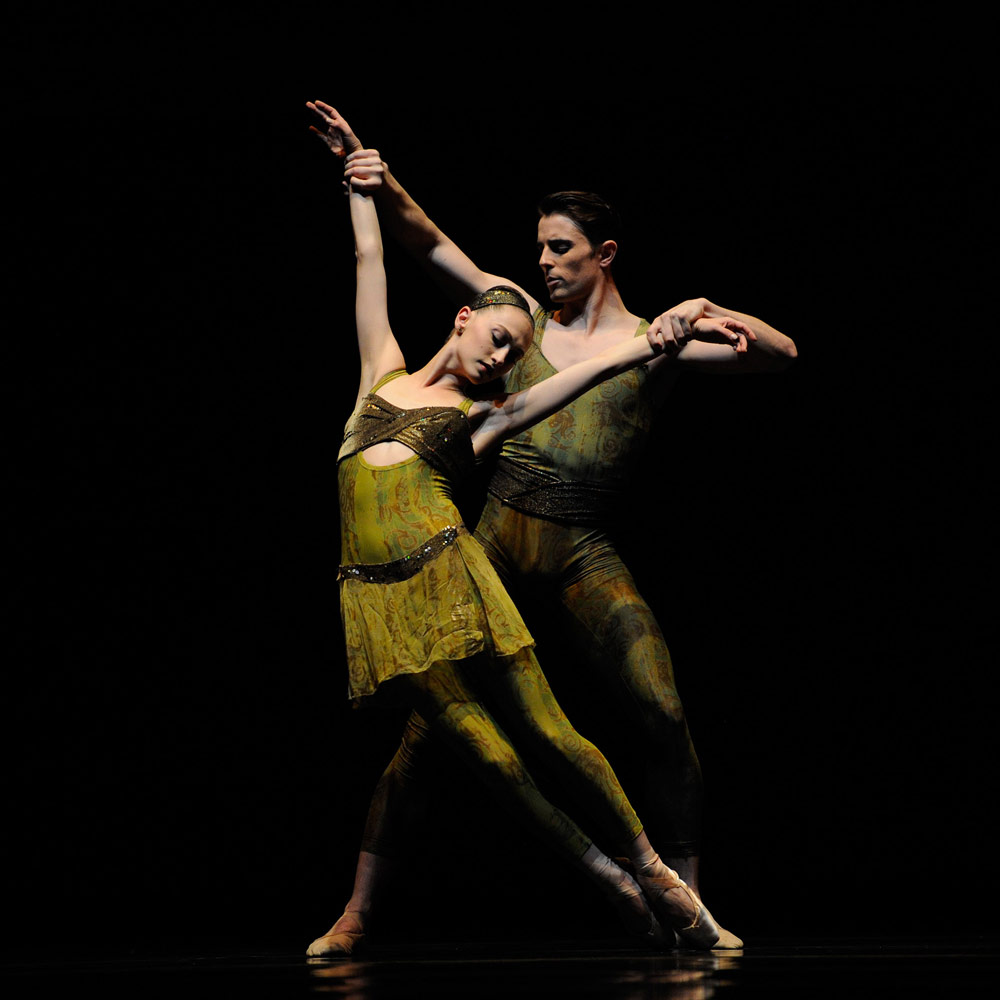
© Erik Tomasson. (Click image for larger version)
There’s no narrative thread for the four duets. One is rather twee, a revue sketch ballroom waltz for a cute couple to plucked strings. Two arresting men dance in counterpoint, sharing the same buoyant steps. Tiny Maria Kochetkova perches on Vitor Luiz’s back, then is twisted around him as though infinitely malleable. Dreamiest of all is a pas de deux to Celtic-sounding music: Sarah Van Patten seems a selkie, a seal-woman more at home in water than on land; she needs Luke Ingham to support her in off-balance swirls until she moves away, poised and elusive.

© Erik Tomasson. (Click image for larger version)
Ensemble dances are intricately organised, dancers linked in a rotating cluster or breaking away from swiftly-dissolving lines. In the final section, all sway from side to side in unison, tick-tocking like a clock’s mechanism – or a Robbins applause routine. Wheeldon’ musicality is ever-evident in this somewhat whimsical work, as is his mastery of construction. Great to see so many of San Francisco Ballet’s dancers enjoying themselves and enthusing their audience in a steamy summer evening in Paris.












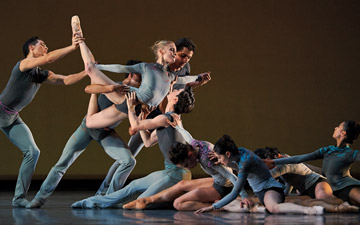

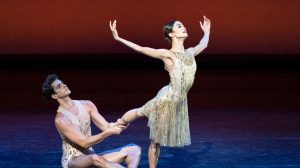
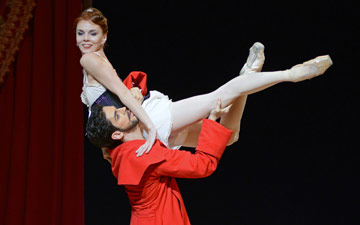
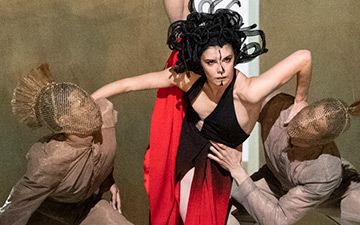
You must be logged in to post a comment.